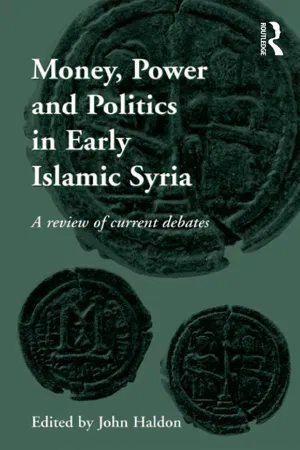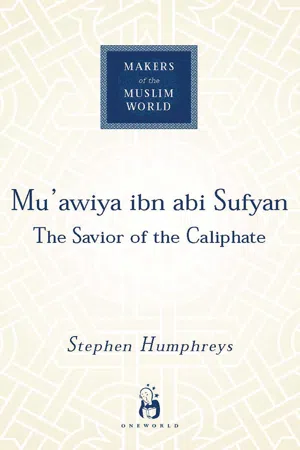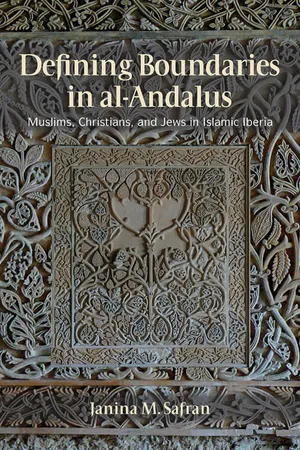History
Mu'awiya
Mu'awiya was the founder of the Umayyad Caliphate and a prominent figure in early Islamic history. He played a significant role in the expansion of the Islamic empire and is known for establishing a hereditary system of succession within the caliphate. His reign marked a transition from the Rashidun Caliphs to the Umayyad dynasty, shaping the future of Islamic governance.
Written by Perlego with AI-assistance
Related key terms
6 Key excerpts on "Mu'awiya"
- eBook - ePub
Money, Power and Politics in Early Islamic Syria
A Review of Current Debates
- John Haldon(Author)
- 2016(Publication Date)
- Routledge(Publisher)
ā wiya’s State Clive FossThe first caliph Abū Bakr sent Mu‘ā wiya and his brother Yazī d with the first Arab armies against Syria in 634.1 When Yazī d, who had been in command, died in 639, Mu‘ā wiya became governor of the province of Damascus, or of Jordan, or of both. He got control of all Syria including upper Mesopotamia around 646, soon after his relative ‘Uthmā n became caliph. His position in Syria made him leader of the aggressive campaigns against Byzantium by land and sea which struck deep into Asia Minor and culminated in a great naval victory in 655. During this period, he exchanged embassies with the Byzantine emperor as well as potentates in Armenia, and seemed to have enjoyed considerable autonomy.When ‘Uthmā n was assassinated in 656, Mu‘ā wiya refused to acknowledge ‘Alī as caliph, and was himself recognized as supreme in Syria in 658; the same year, he took control of Egypt. In July 660, in a formal ceremony, Mu‘ā wiya was proclaimed caliph in Jerusalem; and the following year, with the death of Ali, he took over the entire Islamic realm. He made Damascus his capital and frequently resided there. He ruled successfully, maintaining peace at home, and carrying on the wars against Byzantium, which led to expansion in North Africa and invasion up to the walls of Constantinople. He made major acquisitions in the East. He died in May 680 and was buried in Damascus. In other words, Mu‘ā wiya was the dominant figure in the Near East during the 40 crucial years that saw the establishment and consolidation of the Arab realm, and ruled all of that realm for twenty. He could reasonably be considered the most important secular ruler of the entire 7th century.The present essay aims to expand on this outline by looking at Mu‘ā wiya’s rule in three regions – the East (Iraq and Iran), Syria, and Egypt – which present different kinds of information and problems. Knowledge of the East derives largely from historical writings, of Egypt from documents, while Syria is surprisingly obscure. Discussion of the regions will lead to a central question: did Mu‘ā wiya run an organized state, or did he preside over some kind of tribal confederation, with a low degree of central control, or something else? On the whole scholarly opinion inclines to the negative – that Mu‘ā wiya’s regime was essentially more tribal than bureaucratic, and hardly constituted a state: “… the Sufyanid state was tribally based, even in its metropolis”; “the polity that found itself ruling the conquests was a loose confederation of Arab tribes, not a hegemonic state”; “Mu‘awiya maintained his authority not through a complex centralized bureaucracy but through a system of delegated rule”; “a centralised administrative and fiscal apparatus is absent under Mu‘awiya”.2 On the other hand, Fred Donner, in an important essay written twenty years ago, concluded that “a state did exist from the time of ‘Abd al-Malik and that it probably existed back into the time of Mu‘awiya”.3 I will attempt to support this point of view, bringing it to bear on the reign of Mu‘ā wiya. The discussion will begin with the East, since it is best documented in terms of narrative sources, of which the most important by far is the massive history of al-Ṭ - eBook - ePub
The Prophet and the Age of the Caliphates
The Islamic Near East from the Sixth to the Eleventh Century
- Hugh Kennedy(Author)
- 2022(Publication Date)
- Routledge(Publisher)
4 The Umayyad caliphateDOI: 10.4324/9780429348129-4The Sufyanid caliphs: Mu‘āwiya and his family: 41–64/661–684
The assassination of ‘Alī b. Abī Ṭālib in 40/661 left his rival Mu‘āwiya b. Abī Sufyān as the undoubted strongman of the Muslim community. Mu‘āwiya was by this time in his fifties, having been born in the first decade of the seventh century. His father, Abū Sufyān, had emerged as a leader of the Meccans in the years that followed the battle of Badr and had conducted the negotiations which brought the city to acknowledge the authority of the Prophet. His young son received a political education in the best traditions of the Quraysh. Like his father, he became a Muslim at the time of the conquest of Mecca, that is, later than many over whom he was subsequently to rule, but his education meant that he became one of Muhammad’s secretaries and part of the new Muslim élite. After Muḥammad’s death, he and his elder brother Yazīd went on the expeditions to Syria, where the family had owned property before the coming of Islam. Yazīd’s premature death from plague meant that Mu‘āwiya came to be the leader of the family and governor of Syria after the death of Abū ‘Ubayda. He remained the governor without interruption or challenge for the next twenty years, thus obtaining an unrivalled opportunity to build up and strengthen his power base in the province.While his place in the affections of the Syrians was secure, even his enemies attested that the problems he faced in the rest of the Islamic world were formidable. He had to assert not only his personal power but also the credibility of the caliphate and the unity of the Muslim community, which had been so badly damaged in the preceding years, and he faced opposition not just from people who resented his assumption of power, but from people who resented the whole idea of a strong and effective government. Perhaps his greatest achievement was to ensure that despite the stresses his policy inevitably caused, the Muslim world remained united enough to resist the attacks of its enemies and to expand its own borders. - eBook - ePub
Mu'awiya ibn abi Sufyan
From Arabia to Empire
- Stephen Humphreys(Author)
- 2012(Publication Date)
- Oneworld Academic(Publisher)
LAYING THE FOUNDATIONS OF POWER: MU‘AWIYA AS MASTER OF SYRIA (632–656) MU‘AWIYA AND THE CONQUEST OF SYRIALittle is known of Mu‘awiya in the years immediately following Muhammad’s death in 632. In 636, he emerged from the mist slightly, when he was given command of an advance force that had been roughly handled by the Byzantines near Damascus and whose defeat threatened the Muslim position in Syria.1 He held this command, of 3000 men or even fewer, at the decisive Battle of the Yarmuk in the same year. He led his troops ably but is not mentioned as one of the battle’s heroes. After Yarmuk, his older brother, Yazid, led Muslim forces up the coast of Lebanon, occupying Sidon, Beirut and several other cities. Mu‘awiya served with great distinction as commander of the vanguard of this expedition.Then he moved into more visible roles. He is named as one of the four Muslim witnesses who signed the treaty of capitulation for Jerusalem, which surrendered in December 637 (or February 638) after a two-year siege. The Patriarch Sophronius, who governed Jerusalem on behalf of the Byzantines, demanded that the caliph ‘Umar come to Syria and personally negotiate the terms of surrender; later, they visited Jerusalem together.2 The fall of Jerusalem was immensely significant for the Muslims; for the Byzantines, it was apocalyptic:Sophronius … received a promise of immunity for the whole of Palestine. ‘Umar entered the Holy City dressed in filthy garments of camel-hair and, showing a devilish pretence, sought the temple of the Jews – the one built by Solomon – that he might make it a place of worship for his own blasphemous religion. Seeing this, Sophronius said, ‘Verily this is the abomination of desolation standing in a holy place, as has been spoken through the prophet Daniel’. And with many tears the defender of piety bewailed the Christian people. - eBook - ePub
The Meaning of Mecca
The Politi of Pilgrimage in Early Islam
- M E McMillan(Author)
- 2012(Publication Date)
- Saqi Books(Publisher)
THREE Mu‘āwiyah b. Abī Sufyān: A New Regime and a New Ḥajj Policy Mu‘āwiyah b. Abī Sufyān became caliph in 40/661; a position he held until his death in 60/680. 1 His caliphate covered twenty ḥajj seasons: 40/661 to 59/679 inclusive. Table 2 shows his choice of leaders for the ḥajj during the two decades of his caliphate. Table 2 Year Ḥajj leader Relationship to caliph Governor of Medina? 40/661 al-Mughīrah x x b. Shu‘bah 2 41/662 ‘Utbah b. Abī brother x Sufyān 3 or ‘Anbasah brother x b. Abī Sufyān 4 42/663 ‘Utbah 5 or brother x ‘Anbasah 6 brother x 43/664 Marwān cousin yes b. al-Ḥakam 7 44/665 CALIPH 8 - - 45/666 Marwān 9 cousin yes 46/667 ‘Utbah 10 or brother x ‘Anbasah 11 brother x 47/668 ‘Utbah 12 or brother x ‘Anbasah 13 brother x 48/669 Marwān 14 or cousin yes Sa‘īd b. al-‘Āṣ 15 cousin x 49/670 Sa‘īd 16 cousin yes 50/670-671 CALIPH 17 or - - Yazīd 18 son - 51/671 CALIPH 19 or - - Yazīd 20 son - 52/672 Sa‘īd 21 cousin yes 53/673 Sa‘īd 22 cousin yes 54/674 Marwān 23 cousin yes 55/675 Marwān 24 cousin yes 56/676 al-Walīd nephew x b. ‘Utbah 25 or ‘Utbah 26 brother x 57/677 al-Walīd 27 or nephew yes ‘Uthmān b. nephew x Muḥammad b. Abī Sufyān 28 58/678 al-Walīd 29 nephew yes 59/679 ‘Uthmān 30 or nephew x al-Walīd 31 or nephew yes Muḥammad brother x b. Abī Sufyān 32 MU‘ĀWIYAH AND LEADERSHIP OF THE ḤAJJ Mu‘āwiyah’s elevation to the caliphate in 40/661 brought an end to the fitnah, the time of trial, and the ummah once again saw their communal identity reflected in one caliph. 33 The new caliph introduced a number of far-reaching changes: he was the first of the Prophet’s successors to receive the oath of allegiance, the bay‘ah, outside the Ḥijāz; 34 he relied for support on the pre-Islamic Meccan aristocracy rather than the Islamocracy of Medina; 35 and he made Syria the seat of political power. 36 Yet there was also a degree of continuity with the practices of his predecessors as Mu‘āwiyah re-instated the practice of caliphal leadership of the ḥajj - eBook - ePub
Defining Boundaries in al-Andalus
Muslims, Christians, and Jews in Islamic Iberia
- Janina M. Safran(Author)
- 2013(Publication Date)
- Cornell University Press(Publisher)
56Ibn al-Qutiyya’s account of Ibn Hafsun’s rebellion draws on legendary stories and offers a glimpse of what might have been a popular sympathetic view of the rebel leader. Read this way, the historian’s narrative supports the idea that ʿ Umar ibn Hafsun had a charismatic or ideological appeal that set him apart from other rebels. ʿ Umar ibn Hafsun is identified by signs and prophecies as a man with a destiny (opposition to Umayyad rule) that he cannot avoid.57 The trajectory of Ibn Hafsun’s story follows a heroic pattern: he leaves his home as an outcast and goes into exile, returning when his destiny calls him to take up arms against the oppressor. Ultimately, he comes to terms with the limits of his power—he meets his match.58Ibn al-Qutiyya’s narrative has two cycles; perhaps he has combined two versions of the origins of Ibn Hafsun’s revolt.59 The first cycle, which tells a story of exile and return, insult and vindication, clearly identifies ‘Umar as the hero with a portended destiny. We are told that the cause of ʿ Umar’s revolt was the unjust action of the governor of his home province of Rayya (Malaga), who had him seized and whipped. ʿ Umar flees across the sea to Tahart, where he works for a tailor who is also from Rayya. One day an old man enters the shop, and the tailor introduces him to his assistant simply as his compatriot. The old man asks him, as someone who has recently arrived from Rayya, if he is familiar with Bobastro and if he knows any indications of a movement (ḥaraka ) there. ʿ Umar replies that he lived at the foot of the mountain of Bobastro and that he had not observed anything out of the ordinary. The old man assures him that something will soon occur. He then asks, “Do you know of a man from the region named ʿ Umar ibn Hafsun?” Before ʿ Umar can answer, the old man realizes to whom he is speaking. He urges ʿ - eBook - ePub
- Pierre Cachia(Author)
- 2017(Publication Date)
- Routledge(Publisher)
The Arabs, though only a small section of the inhabitants of al-Andalus, gave a certain colour to the whole civilisation. Here, however, we come upon one of the central problems in the history of Islamic culture in Spain. How strong was the religious and cultural influence of the Arabs? In what precise forms did it manifest itself? How did it come to be so strong? It is easy to understand in a general way the basis of Arab influence. In the heartlands of Islam the period of the Umayyad caliphate of Damascus is regarded as one of Arab domination. This is in contrast to the 'Abbasid period in which Persian elements came to the fore. From the conquest until 750 al-Andalus was a province of the Umayyad caliphate of Damascus, and then for another two and a half centuries it was ruled by the Umayyad family. There was much more to it, however, than the mere fact of rule. The Arabs were characterised by intense self-confidence or belief in themselves; and this, coupled with their superior economic position—they had lands in the richest parts of the country—must have led the other sections of the population to admire and emulate them. At first non-Arabs who became Muslims were clients of members of Arab tribes, and often adopted the patron's genealogy; in course of time the point at which the genealogy became fictitious was forgotten, and the clients began to pass themselves off as pure Arabs.This "arabising" of Spain appears at many points—the name "Mozarabs" (meaning "arabisers") for the Christian living under Muslim rule, the interest in Arab genealogy and other questions of Arab origins, the dominance of the distinctively Arabian Mālikite legal rite, and above all the popularity of the language. It is not clear that the original Arab invaders and settlers brought much culture with them. What was probably more important was that they remained in contact with the Arabic-speaking lands in the Middle East, and were therefore able to benefit from the cultural advances made there.Much more numerous than the Arabs in the strict sense were the muwaUads or Muslims of Iberian stock. In course of time many of them adopted purely Arab genealogies; the writer Ibn-IJazm (p. 111) actually claimed descent from an arabised Persian. The confusion brought about by such genealogies was not serious from any practical point of view. Descent was reckoned only in the male line, but the original Arabs had married Iberian women freely, so that by the tenth century there was no clear racial distinction between Arabs and muwaUads.
Learn about this page
Index pages curate the most relevant extracts from our library of academic textbooks. They’ve been created using an in-house natural language model (NLM), each adding context and meaning to key research topics.





